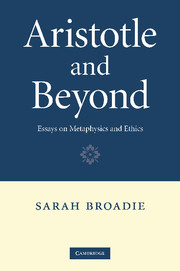Book contents
- Frontmatter
- Contents
- Preface
- Acknowledgments
- Chapter 1 Affecting and being affected
- Chapter 2 Backwards causation and continuing
- Chapter 3 From necessity to fate: An inevitable step?
- Chapter 4 Alternative world-histories
- Chapter 5 A contemporary look at Aristotle's changing Now
- Chapter 6 Nature and craft in Aristotelian teleology
- Chapter 7 Soul and body in Plato and Descartes
- Chapter 8 Aristotle and contemporary ethics
- Chapter 9 On the idea of the summum bonum
- Chapter 10 What should we mean by ‘the highest good’?
- Chapter 11 The good of practical beings: Aristotelian perspectives
- Chapter 12 Taking stock of leisure
- References
- Index of names
Chapter 5 - A contemporary look at Aristotle's changing Now
Published online by Cambridge University Press: 25 June 2009
- Frontmatter
- Contents
- Preface
- Acknowledgments
- Chapter 1 Affecting and being affected
- Chapter 2 Backwards causation and continuing
- Chapter 3 From necessity to fate: An inevitable step?
- Chapter 4 Alternative world-histories
- Chapter 5 A contemporary look at Aristotle's changing Now
- Chapter 6 Nature and craft in Aristotelian teleology
- Chapter 7 Soul and body in Plato and Descartes
- Chapter 8 Aristotle and contemporary ethics
- Chapter 9 On the idea of the summum bonum
- Chapter 10 What should we mean by ‘the highest good’?
- Chapter 11 The good of practical beings: Aristotelian perspectives
- Chapter 12 Taking stock of leisure
- References
- Index of names
Summary
The aim of this paper is to bring two ideas together for mutual illumination. One is Aristotle's conception of the now as ‘always different and different’ (Physicsiv.10, 218a10; 11, 219b12–23); the other is the modern dichotomy of time into the two aspects of order and passage. This dichotomy was first formulated in 1908 by the Cambridge philosopher, J. M. E. McTaggart, who made it the basis of a brilliant and controversial proof of the unreality of time. From then on McTaggart's distinction has dominated discussion of time among analytic philosophers; hence it provides a contemporary perspective from which to think about Aristotle's contribution.
On one side of the distinction, events are considered as past, present, and future, and their occurrence is expressed by sentences with tensed verbs. The most striking thing about this approach is that the attributes of being future, present, and past, and the corresponding tenses, take it in turns to belong to each successive set of events. Consequently, what lies (as we say) in the future, in the present, and in the past, is changing from moment to moment. The occasion for which this paper was first written was once future, later on was present, and in a few more days was completely in the past, even if long to be remembered. We can think of each event as passing from the future through the present to the past. Alternatively, we can think of the future, the present, and the past as temporal locations whose contents are always changing in a regular way.
- Type
- Chapter
- Information
- Aristotle and BeyondEssays on Metaphysics and Ethics, pp. 72 - 84Publisher: Cambridge University PressPrint publication year: 2007



